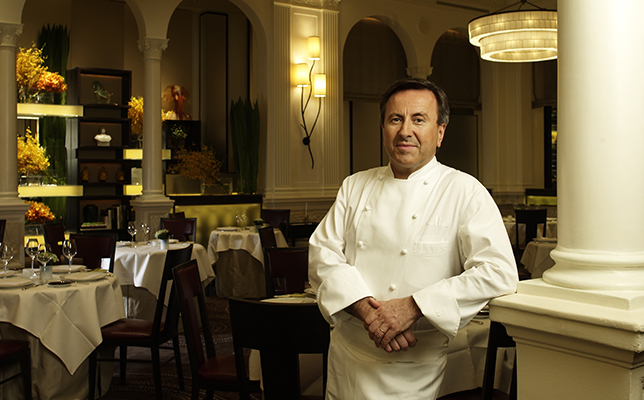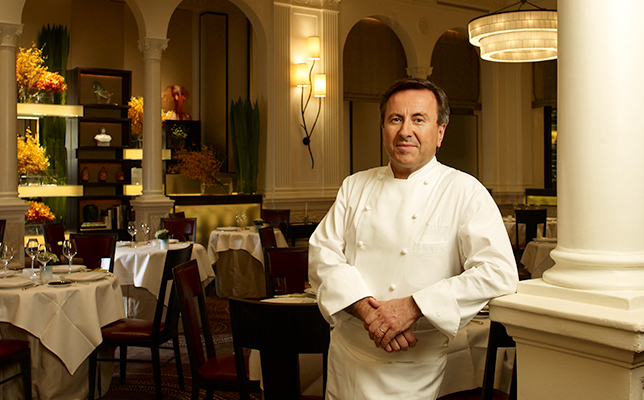
Since coming to the U.S. in the early ’80s, the French chef has built a culinary empire. And this year, after more than 30 years in the States, Forbes Travel Guide Tastemaker Daniel Boulud celebrates yet another milestone: the 20th anniversary of his New York fine-dining restaurant, Daniel. His eponymous establishment has earned its Forbes Travel Guide Five-Star rating since 1997 — quite a feat in any city, much less New York. With restaurants all over the world, ranging from gastropub DBGB Kitchen and Bar to the elaborate testing menus at Daniel, Boulud has plenty to be proud of. Our Forbes Travel Guide editors recently caught up with the top toque to chat about how he’s celebrating two decades in the fine-dining realm, his just-released cookbook, Daniel: My French Cuisine, and the newly reopened db Bistro Moderne.
Are you doing anything special to celebrate the 20th anniversary of Daniel?
We have been doing things to celebrate all year long. Of course, the kickoff celebration was the Citymeals-on-Wheels dinner, where 20 [Daniel] alumni cooked a dinner with me to raise money for Citymeals, and we raised almost $600,000. Then we kept doing some special events like that. The next one is four nights (October 14-18) of 10-course, 10-wine menus in celebration of the 20 years, and a cookbook, of course, [comes] with it as a souvenir. We’re going to have limited seating for that at Daniel, where we choose to only have like six tables a night doing that menu. There will be some classics from over the years. There will also be some dishes of today.
In the past 20 years of your career, what are you most proud of?
I think over the last 20 years, what I’m the most proud of is to have been associated with New York as a chef and to have been blessed with amazing energy around me — from the young chefs to the customers, the team, the suppliers, the food. I think I have accomplished many milestones in these 20 years. I was also awarded many accolades for the hard work and what I believe was right for my customer, the restaurant, the team, New York.
I think the ingredient of success is to pick it up every day and work with it. It’s never something to take for granted. Just because people like you today doesn’t mean they’re going to continue to like you tomorrow. I never take it for granted. I also think it’s trust. The biggest thing, over the last 20 years, is that I always wanted the customer, my staff and the suppliers to trust me, and to make sure the trust was really consistent. I continue to try to be very trustworthy.
Within those 20 years, you’ve written quite a few cookbooks, and your new one comes out tomorrow. What was the inspiration for this one?
I think all the other cookbooks were fairly simplified for home. With this book, I made a commitment with the chefs that we will not change the recipe. It will be what we do at Daniel — as complicated, complex and labor intensive. At the same time, I think the book has to remain an aspiration. It was about showing who I am here at Daniel, what we do here and what Daniel represents for me. I think it does capture me a lot through the restaurant. I think it also captures the teamwork well. It certainly captures the French foundation of all of it, but also the creativity. Many dishes have nothing to do with French cuisine; but I think the way the dishes are prepared and approached have a lot to do with French technique.
You just reopened db Bistro Moderne in September. What made you want to redesign the space and menu?
I think it’s just like what we did at Daniel. After [15] years at Daniel, we decided to redo the restaurant because we wanted to keep the motivation running. I think the story of success here in New York is to never really take advantage of your business but keep reinvesting for the pleasure of the customer, the motivation of the staff and the ambition to keep going with our restaurants. We are blessed to be successful, so we should be giving back as well. I think redoing db Bistro after 12 years was motivating and exciting.
It’s still db Bistro in what we want to offer to our customer — the price point we want to keep, the style of restaurant db represents. We created a feel that’s maybe a little bit more classic, a little more French; but, at the same time, the menu reflects a little bit more of a classic [cuisine] and a little bit more of a contemporary [cuisine]. That’s why we have two menus — “Cuisine Classique” and “Cuisine du Marché” — which are very much the two things that have been driving my life in the kitchen and the motivation I have in cooking.
What can diners expect from these two new menus?
They should expect Daniel at db Bistro, which is always, to many customers, about me at an approachable, affordable, casual venue. There are some classic dishes that are revisited because they are lighter; we are very conscious with health in our cuisine, but we don’t want to take away flavor — we try to maintain a good balance with that. For example, I do a very classic leek vinaigrette; but instead of doing the classic simple leeks with mustard vinaigrette and chopped eggs on top, I do poached leeks with carrot coulis (roasted and shaved carrots) and a six-minute egg on top. The leeks and the mustard and the combination of all the seasoning are very satisfying and very French, but also “today” as well.
We do a salmon coulibiac, which is a very classic, old New York dish that I learned from Pierre Franey and Craig Claiborne. I never did the dish in France, but I did it here. I thought it would be good to bring back the ’60s and ’70s of the old French chefs of New York in a little more technically up-to-date approach. It’s the same thing with the fluke Veronique with a grape sauce, which was a classic in the French restaurants when I arrived in New York in the early ’80s, where they were all doing Dover sole Veronique. It’s a little ode to my French pals of the past — Jacques Pépin and Pierre Franey — and many of the great chefs — Jean-Jacques Rachou — of the time who were influential there.
Of course, we keep the coq au vin as a classic. It is, and always will be, the home of the [Original] db Burger. It was an instant classic the day it was born, and the recipe hasn’t changed and will never change. It’s amazing — the people who come just to have a db Burger. It’s unique. There have been a lot of imitators of gourmet burgers, but I think the db Burger is different.
Both Cuisine Classique and Cuisine du Marché will keep evolving and changing with the seasons. Right now, we have a fennel pollen risotto. It’s a fennel risotto with blue prawn carpaccio. We put it right over the hot risotto and let the blue prawns cook. We have a lightly smoked halibut with shallot confit, a little soubise (which is a creamy roasted sweet onion sauce), Brussels sprouts and a little bit of cauliflower. I think it’s very light, very tasty and very bistro in a way.
To me, for a successful bistro dish, less is more. I think it has to have simplicity, but also resonate with great flavor and great technique, and have a sense of either history or presence with the market.
On October 23, you’re going out to Los Angeles to cook with [Forbes Travel Guide Tastemaker] Wolfgang Puck at [Forbes Travel Guide Five-Star] Hotel Bel-Air. It’s your first time cooking with him, correct?
Yes. Well, we’ve cooked in charities a lot, but it’s my first time cooking with him. We’re going to have fun. I’m going to do three courses and he’s going to do two. I want to do a dish that is related to the book.
I’m going to start with a caraway-cured Tai snapper. I’ll cure the Tai snapper with caraway and a little bit of cucumber. It takes me back a little bit to Denmark, where they do all these cucumber salads with caraway in it, or they use caraway in different preparations, even in their own aquavit. Here, we’ll cure Tai snapper with it and have a whole garnish of little crudités. There’s some dill also with the preparation — caraway and dill are very similar in flavor. Then there will be a cucumber gazpacho with citrus and a bit of caviar on top.
[For the second course], I’m going to do Santa Barbara spot prawns, which are local there. I’ll take phyllo dough and shred it very finely, then wrap the prawns inside. I’ll serve it on a little salad of heart of palms seasoned with tandoori, and also some seasoned kumquats. This is as un-French as you can be and yet the technique with the preparation is very French.
Then after, I’m doing a Dover sole à la polonaise. It has eggs, capers and croutons. The sole is covered with that little crust. It’s served with cauliflowers in two ways. That’s a little more classic in the approach. Then, Wolfgang will take care of the meat and the dessert.

